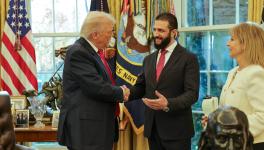An End of War Declaration May Be Reached in the US – N. Korea Summit, Says S. Korea

Ahead of the second summit between the American president, Donald Trump, and North Korean Chairman, Kim Jong-un, in Vietnam’s capital city of Hanoi on February 27 and 28, South Korea has indicated that the rendezvous might yield an ‘End of War Declaration’ between the US and North Korea.
“We still do not know exactly what format the end-of-war declaration will take, but there is an ample possibility of North Korea and the United States agreeing to such a declaration,” the spokesperson of South Korean president, Moon Jae-in, said on Monday.
Moon has been urging the US to agree to such a declaration since Trump’s three-day long summit meet with Kim in the North Korean capital of Pyongyang last September. At the time, the negotiations between the US and North Korea had reached a stalemate.
The US demanded that North Korea completely and verifiably dismantle its nuclear capabilities before it makes any concessions in the form of easing the sanctions or ending hostilities and restoring normal diplomatic relations. North Korea, on the other hand, insisted that before it can undertake compete denuclearization, the US must first sign a peace treaty to assure the regime that it faces no more security threat from them. In absence of a peace treaty, the two sides continue to technically remain in a state of war, which was only halted with an armistice in 1953.
One of Moon’s main agendas behind his September summit with Kim was to break this impasse. “This is not a matter on which we can take the lead, so (I) hope to speak frankly with Chairman Kim Jong-un to find a middle ground between the US’ demands for denuclearization and the North’s demands for ending hostilities and ensuring safety (of the regime),” he stated at a press conference prior to the meeting.
The “middle ground”, which both Koreas agreed upon in the meeting, was to seek an End of War Declaration from US. Moon clarified that it was not exactly a peace treaty, but a political declaration that would serve “as starting point for peace negotiations for the signing of a peace treaty” and that “when the North achieves complete denuclearization, the treaty will be signed and, at the same time, the North-US relations will be normalized.”
The following month, days before US state secretary Mike Pompeo paid a visit to Kim to discuss the second meeting between the latter and Trump, South Korean foreign minister, Kang Kyung-wha, indicated that the US had been considering such a declaration.
However, even though Moon had assured that such a declaration will not require removal of the 28,500 US soldiers stationed in South Korea, there has been opposition to it from sections of the US establishment. This is because if such a declaration makes way towards an eventual peace treaty, the US will not longer be able cite the need to protect South Korea from the North as a justification for its continued military presence.
Most of these troops are stationed at the largest overseas military base of the US, Camp Humphreys, located to the south of Seoul. Of the USD 10.8 billion that was spent on construction of the base, South Korea had to pay USD 9.7 billion as “protection money”. Earlier this year, at the insistence of US, South Korea agreed to increase the financial burden of operating this base, that it had taken upon itself, by 8%. This will cost the country USD 927 million annually.
A peace treaty will not only result in opposition to the continued presence of US troops in the region by large sections of South Koreans, and indeed by North Korea, but also by Russia and China, both of which are wary of US military presence in the region.
Since the first meet between Kim and Moon in the border village of Panmunjom in April last year, the two Koreas have made significant advances towards ending hostilities. In the meeting, the two sides committed to jointly work towards ceasing military hostilities, deepening economic ties and eventually towards denuclearization and reunification of the divided nation.
However, US’ unwillingness to compromise has hindered the progress. South Korea has also been seeking an exemption from the US-led international sanctions against North Korea, which prohibits the former from engaging in the mutually beneficial infrastructure projects that the two sides have agreed to undertake jointly.
“[T]he core sanctions, the core UN Security Council resolution sanctions, we’ve said consistently full, verified denuclearization – that’s the standard for relieving those sanctions. That policy has not changed..,” Pompeo saidtwo days before his arrival in Hanoi on February 26. He added that “the security assurances that they need can be provided in a way that is reasonable,” indicating a willingness to discuss the End of War Declaration.
However, as Moon’s spokesperson admitted, the content of this declaration is not yet clear. Unless the declaration – if at all made – provides a meaningful assurance that US will not pose a security threat to the North, it is unlikely to mark a real beginning of the process of complete denuclearization.
Get the latest reports & analysis with people's perspective on Protests, movements & deep analytical videos, discussions of the current affairs in your Telegram app. Subscribe to NewsClick's Telegram channel & get Real-Time updates on stories, as they get published on our website.
























